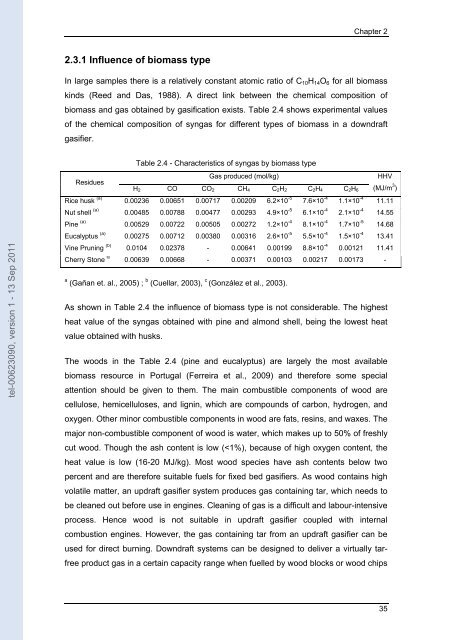Etude de la combustion de gaz de synthèse issus d'un processus de ...
Etude de la combustion de gaz de synthèse issus d'un processus de ...
Etude de la combustion de gaz de synthèse issus d'un processus de ...
Create successful ePaper yourself
Turn your PDF publications into a flip-book with our unique Google optimized e-Paper software.
Chapter 2<br />
2.3.1 Influence of biomass type<br />
In <strong>la</strong>rge samples there is a re<strong>la</strong>tively constant atomic ratio of C 10 H 14 O 6 for all biomass<br />
kinds (Reed and Das, 1988). A direct link between the chemical composition of<br />
biomass and gas obtained by gasification exists. Table 2.4 shows experimental values<br />
of the chemical composition of syngas for different types of biomass in a downdraft<br />
gasifier.<br />
tel-00623090, version 1 - 13 Sep 2011<br />
Table 2.4 - Characteristics of syngas by biomass type<br />
Gas produced (mol/kg)<br />
HHV<br />
Residues<br />
H (MJ/m 3 2 CO CO 2 CH 4 C 2 H 2 C 2 H 4 C 2 H 6<br />
)<br />
Rice husk (a) 0.00236 0.00651 0.00717 0.00209 6.2×10 -5 7.6×10 -4 1.1×10 -4 11.11<br />
Nut shell (a) 0.00485 0.00788 0.00477 0.00293 4.9×10 -5 6.1×10 -4 2.1×10 -4 14.55<br />
Pine (a) 0.00529 0.00722 0.00505 0.00272 1.2×10 -4 8.1×10 -4 1.7×10 -5 14.68<br />
Eucalyptus (a) 0.00275 0.00712 0.00380 0.00316 2.6×10 -5 5.5×10 -4 1.5×10 -4 13.41<br />
Vine Pruning (b) 0.0104 0.02378 - 0.00641 0.00199 8.8×10 -4 0.00121 11.41<br />
Cherry Stone © 0.00639 0.00668 - 0.00371 0.00103 0.00217 0.00173 -<br />
a (Gañan et. al., 2005) ; b (Cuel<strong>la</strong>r, 2003), c (González et al., 2003).<br />
As shown in Table 2.4 the influence of biomass type is not consi<strong>de</strong>rable. The highest<br />
heat value of the syngas obtained with pine and almond shell, being the lowest heat<br />
value obtained with husks.<br />
The woods in the Table 2.4 (pine and eucalyptus) are <strong>la</strong>rgely the most avai<strong>la</strong>ble<br />
biomass resource in Portugal (Ferreira et al., 2009) and therefore some special<br />
attention should be given to them. The main combustible components of wood are<br />
cellulose, hemicelluloses, and lignin, which are compounds of carbon, hydrogen, and<br />
oxygen. Other minor combustible components in wood are fats, resins, and waxes. The<br />
major non-combustible component of wood is water, which makes up to 50% of freshly<br />
cut wood. Though the ash content is low (

















